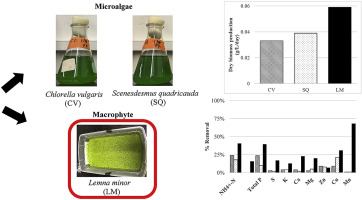当前位置:
X-MOL 学术
›
J. Environ. Manag.
›
论文详情
Our official English website, www.x-mol.net, welcomes your
feedback! (Note: you will need to create a separate account there.)
Comparison of nutrient removal and biomass production between macrophytes and microalgae for treating artificial citrus nursery wastewater.
Journal of Environmental Management ( IF 8.0 ) Pub Date : 2020-04-04 , DOI: 10.1016/j.jenvman.2020.110303 Ferisca E Putri 1 , Tien-Chieh Hung 1
Journal of Environmental Management ( IF 8.0 ) Pub Date : 2020-04-04 , DOI: 10.1016/j.jenvman.2020.110303 Ferisca E Putri 1 , Tien-Chieh Hung 1
Affiliation

|
Macrophyte (Lemna minor) and microalgae (Chlorella vulgaris and Scenesdesmus quadricauda) were used for treating artificial wastewater mimicking recirculating soilless citrus nursery system discharge in the laboratory environment. L. minor gave a better dry biomass yield (0.059 ± 0.003 g/L/day) than C. vulgaris (0.033 ± 0.002 g/L/day) and S. quadricauda (0.039 ± 0.001 g/L/day). Furthermore, L. minor had a higher nutrient (total N and P) and soluble minerals (S, K, Ca, Mg, Zn, Cu, and Mn) removal capabilities than microalgae due to a more natural high growth rate in non-optimized culture conditions.
中文翻译:

比较大型植物和微藻处理人工柑橘苗圃废水的养分去除和生物量生产。
在实验室环境中,使用大型水生植物(Lemna minor)和微藻类(小球藻和小球藻Scenesdesmus quadricauda)来处理人工废水,模拟循环的无土柑桔苗圃系统的排放。较小的利什曼原虫干杂种产量(0.059±0.003 g / L / day)比寻常小球藻(0.033±0.002 g / L / day)和苦豆链霉菌(0.039±0.001 g / L / day)好。此外,由于未优化中更自然的高生长速率,次要乳酸杆菌比微藻具有更高的养分(总氮和磷)和可溶性矿物质(硫,钾,钙,镁,锌,铜和锰)的去除能力。文化条件。
更新日期:2020-04-06
中文翻译:

比较大型植物和微藻处理人工柑橘苗圃废水的养分去除和生物量生产。
在实验室环境中,使用大型水生植物(Lemna minor)和微藻类(小球藻和小球藻Scenesdesmus quadricauda)来处理人工废水,模拟循环的无土柑桔苗圃系统的排放。较小的利什曼原虫干杂种产量(0.059±0.003 g / L / day)比寻常小球藻(0.033±0.002 g / L / day)和苦豆链霉菌(0.039±0.001 g / L / day)好。此外,由于未优化中更自然的高生长速率,次要乳酸杆菌比微藻具有更高的养分(总氮和磷)和可溶性矿物质(硫,钾,钙,镁,锌,铜和锰)的去除能力。文化条件。











































 京公网安备 11010802027423号
京公网安备 11010802027423号